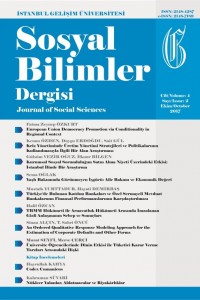An Ordered Qualitative Response Modeling Approach for the Estimation of Corporate Defaults and Other Forms of Exit
Öz
We
propose a new approach for the estimation of defaults and other forms of exit
of borrowers. Our approach is based on the ordered qualitative response model.
We first show that any ordered qualitative response model is equivalent to the
competing risks model – commonly employed in the estimation of corporate
defaults and other forms of exit – in continuous-time. We then construct the
continuous-time likelihood function of the models and further present its
discrete-time simplification. Lastly, we compare and contrast the competing
risks and ordered qualitative response models through numerical experiments in
a two-state setting, and demonstrate that none of the alternatives necessarily
dominates the others. Our results indicate that it may be worthwhile to
estimate the models in continuous-time.
Anahtar Kelimeler
Banking Risk Management Finance Econometrics Financial Econometrics
Kaynakça
- AMEMIYA, Takeshi, “Qualitative Response Models”, Annals of Economic and Social Management, 4 (3), 1975, pp. 363-372.
- DAS, Sanjiv, Darrel DUFFIE, Nikunj KAPADIA, and Leandro SAITA, “Common Failings: How Corporate Defaults are Correlated”, Journal of Finance, 62, 2007, pp. 93–117.
- DUFFIE, Darrel, Andreas ECKNER, Guillaume HOREL, and Leandro SAITA, “Frailty Correlated Default”, Journal of Finance, 64, 2009, pp. 2089–2123.
- DUFFIE, Darrel, Leandro SAITA, and Ke WANG, “Multi-period Corporate Default Prediction with Stochastic Covariates”, Journal of Financial Economics, 83 (3), 2007, pp. 635–665.
- SHUMWAY, Tyler, “Forecasting Bankruptcy More Accurately: A Simple Hazard Model”, Journal of Business, 74, 2001, pp. 101–124.
Şirket Temerrütleri ve Diğer Türden Şirket Çıkışlarının Tahmini için Bir Sıralı Nitel Tepki Modelleme Yaklaşımı
Öz
Temerrütler
ve diğer türden şirket çıkışlarının tahmini için yeni bir yaklaşım öneriyoruz.
Yaklaşımımız sıralı nitel tepki modeli üzerine kuruluyor. Önce, sıralı nitel
tepki modelinin – şirket temerrütleri ve diğer türden şirket çıkışları
tahmininde sıkça kullanılan – rakip riskler modeline sürekli zamanda denk
olduğunu gösteriyoruz. Sonra, modellerin sürekli zaman olabilirlik fonksiyonunu
kuruyor ve daha sonra, bu fonksiyonun basitleştirilmiş kesikli zaman şeklini
sunuyoruz. Son olarak, iki durumlu bir uzayda yaptığımız sayısal deneylerle
rakip riskler ve sıralı nitel tepki modellerini karşılaştırıyoruz ve
seçeneklerden hiçbirinin diğerine yeğlenir olması gerekmediğini gösteriyoruz.
Elde ettiğimiz sonuçlar modellerin sürekli zamanda tahminlerinin yararlı olabileceğini
gösteriyor.
Anahtar Kelimeler
Bankacılık Risk Yönetimi Finans Ekonometri Finansal Ekonometri
Kaynakça
- AMEMIYA, Takeshi, “Qualitative Response Models”, Annals of Economic and Social Management, 4 (3), 1975, pp. 363-372.
- DAS, Sanjiv, Darrel DUFFIE, Nikunj KAPADIA, and Leandro SAITA, “Common Failings: How Corporate Defaults are Correlated”, Journal of Finance, 62, 2007, pp. 93–117.
- DUFFIE, Darrel, Andreas ECKNER, Guillaume HOREL, and Leandro SAITA, “Frailty Correlated Default”, Journal of Finance, 64, 2009, pp. 2089–2123.
- DUFFIE, Darrel, Leandro SAITA, and Ke WANG, “Multi-period Corporate Default Prediction with Stochastic Covariates”, Journal of Financial Economics, 83 (3), 2007, pp. 635–665.
- SHUMWAY, Tyler, “Forecasting Bankruptcy More Accurately: A Simple Hazard Model”, Journal of Business, 74, 2001, pp. 101–124.
Ayrıntılar
| Bölüm | Makaleler |
|---|---|
| Yazarlar | |
| Yayımlanma Tarihi | 31 Ekim 2017 |
| Kabul Tarihi | 31 Temmuz 2017 |
| Yayımlandığı Sayı | Yıl 2017 Cilt: 4 Sayı: 2 |
 İstanbul Gelişim Üniversitesi Sosyal Bilimler Dergisi Creative Commons Atıf-GayriTicari-Türetilemez 4.0 Uluslararası Lisansı ile lisanslanmıştır. |
|---|


